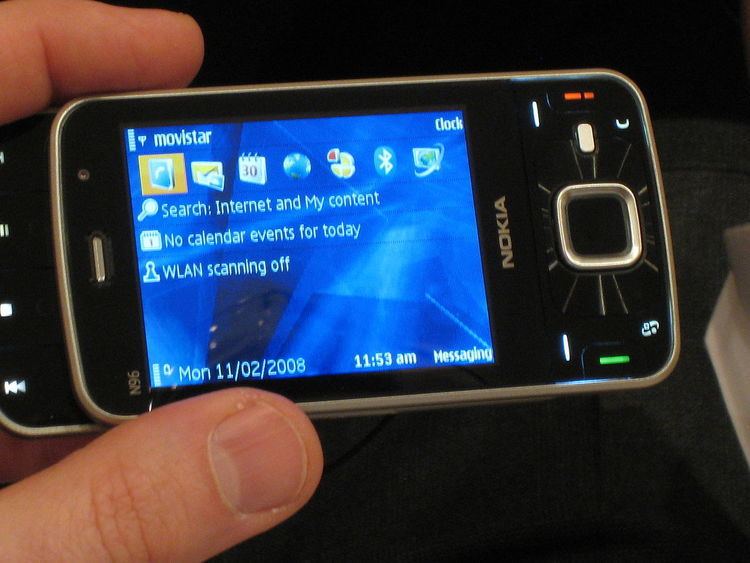Nokia N96 is a high-end smartphone, announced by Nokia on February 11, 2008 at the Mobile World Congress in Barcelona, part of the Nseries line. The N96 runs on the updated Symbian OS v9.3 (S60 3rd Edition, FP2). It was compatible with the N-Gage 2.0 gaming platform and also had a DVB-H tuner to watch TV. It is the official successor to the popular Nokia N95 8GB.
Unlike its predecessors, the N96 was never as popular. Despite numerous improvements such as a doubled flash storage capacity, critics had negative views on the N96's battery life, unreliable software, its expensive price tag and for being very user-unfriendly. As a result, the N96 has been deemed as a 'flop' (commercial failure), contrasting to the N95. It was largely outsold by Nokia's touchscreen smartphone released during the same time, the Nokia 5800 XpressMusic. Its successor Nokia N97 was announced just 3 months after release.
Shipments for the N96 started in September 2008. Europe, Middle East and Asia-Pacific are the first locations to provide the handset for consumers. The American and Chinese versions were expected shortly thereafter. In the U.S., the device was sold for US$900, which was criticised for being too expensive. The general UK release date for the N96 was 1 October, although London had a separate date of 24 September when the device went on sale exclusively at Nokia's flagship stores on Regent Street and at Terminal 5 (Heathrow Airport).
Major differences between N95 8GB and N96
Additions:
Dual-LED camera flash (single LED in the N95 8 GB)New audio DSPLonger music playback time (14 hrs) and video playback time (6 hrs)Windows Media WMV9 video codec addedHardware acceleration for video codecs for H.264 and WMVMobile TV DVB-H 1.0 receiver built in – only with paid subscriptionFlip-out stand for more comfortable viewing of content when device is placed on a flat surface (surrounds the lens assembly)S60 3rd Edition is upgraded from Feature Pack 1 to Feature Pack 2linu v88.0.12.0The Java ME engine is upgraded from MIDP 2.0 to MIDP 2.1User data is preserved when upgrading firmware (this feature is also present on the N95-2 as v21 installs UDP base files)Open C/C++ supportNew QuickOffice application opens all types of Microsoft Office filesNew version of Nokia Video Centre (show & edit videos)New release of Nokia Experience softwareMicro 2.0 Hi-Speed USB (write 3 Mbit/s, read 4.1 Mbit/s – N95 8 GB use full-speed USB)MicroSD memory card slot (as in original N95, while N95 8 GB has no card slot)RSS 2.1 ReaderFM radio upgraded with RDSN96 is a dual-band HSDPA (900 and 2100 MHz, while N95 was a single band 2100 MHz)No need to open the slide for optimal GPS receptionNokia N96 has VGA front camera (N95 8G has CIF)Video Flash lightgunsUpgraded Bluetooth stereo audioFOTA (Firmware Over the Air)OMA E-mail Notification v1.0OMA Device Management v1.2OpenGL ES 1.1 pluginDual Transfer Mode (MSC 11)Support SPP Bluetooth profilesNegative:
TV mode – not availableFree sat nav – not available – Nokia advises that it is in the pipeline and they fully expect it to be made available, but will not say when it is available yetNokia Music Headset HS-45, AD-54CPU: N96 has dual ARM9 264 MHz with no floating point instructions (N95 has dual ARM11 332 MHz with vector floating point)N96 has 8x image digital zoom and 4x video digital zoom (while N95 has 20x digital zoom and 8x video digital zoom), although the benefits of this are debatable.Same battery as original N95 (950 mAh), but the N96 reportedly has a much better battery life using the same battery due to software improvements under Feature Pack 2 (Nokia N95 8GB has 1200 mAh battery)No hardware 3D graphics acceleratorNo infrared portN95 has lens cover and much more qualitative shutter (N95 8GB/N96 don't have this feature)No manually selected MMS messaging mode. If you write a long text message it will automatically select the MMS mode which could stop the recipient from receiving the message if they do not have MMS set up on their handset. (A Nokia USA employee stated that there is an update in the works to fix this very soon) It's assumed that this automatic selection of MMS mode is due to Nokia's Smart Connectivity)VoIP 2.1 support for WLAN and Cellular. However, the built-in VoIP client from N95 which allowed the end-user to make internet calls directly without installing any additional software has been removed from N96. Nevertheless, the VoIP API still exists which can be used by software developers in their applications.The pencil button that is used to mark/unmark items and highlight text is not included. But this action can still be done however, by pressing and holding down the # key'.
